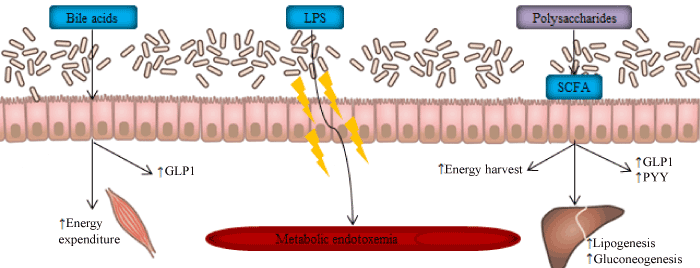| Figure 1: Three suggested mechanisms of how gut microbiota may affect development of obesity and related pathologies. Bacteria residing in the colon are able to convert de-conjugated primary bile acids into secondary bile acids. The secondary bile acids bind to the TGR5 receptor and activate GLP1 secretion from the intestinal
L-cells, resulting in increased energy expenditure in muscle and secretion of Glucagon Like Peptide-1 (GLP1) from the intestinal L-cells, a signalling pathway, which counteracts metabolic dysfunction. Lipopolysaccharides (LPS), in chylomicrons secreted from intestinal epithelial cells or absorbed through increased intestinal
permeability, induce metabolic endotoxemia by triggering secretion of pro-inflammatory cytokines. Short Chain Fatty Acids (SCFA) as butyrate, propionate and acetate
are produced through fermentation of complex polysaccharides by the colonic gut bacteria and enter the circulation. The complex polysaccharides would without the
gut microbiota be indigestible but due to microbial fermentation of indigestible carbohydrates the total amount of harvested energy increases. Butyrate and propionate
trigger the release of the peptide hormones GLP1 and Peptide YY (PYY), possibly reducing food intake. Acetate and propionate mainly function as substrates for
intestinal gluconeogenesis and hepatic lipogenesis.In the one locus model, those gametes having S-j gene are partially aborted in the hybrid genotypes S-i/ S-j. |

